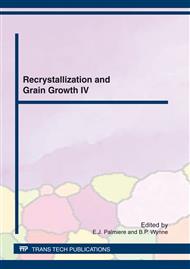p.946
p.952
p.953
p.959
p.965
p.971
p.977
p.983
p.988
Modelling of Recrystallization Curves of Porous Copper-Titanium Powder Materials
Abstract:
In this paper, modelling and plotting of recrystallization curves of copper-titanium powder materials with titanium content of 0.5%, porosity 5% and 10%. The mathematical model that describes an influence of temperature, degree of deformation, strain rate, initial grain size and porosity to grain size after deformation has developed. The interconnection of deforming parameters and structure has presented by function of several variables with analytical expression obtained by method of undetermined coefficients based on experimental data. Theoretical recrystallization curves for copper-titanium powder materials with different porosity have plotted. It has established that porosity decelerates the kinetics of structure formation during dynamical softening of porous powder materials.
Info:
Periodical:
Pages:
965-970
Citation:
Online since:
April 2012
Authors:
Price:
Сopyright:
© 2012 Trans Tech Publications Ltd. All Rights Reserved
Share:
Citation:


